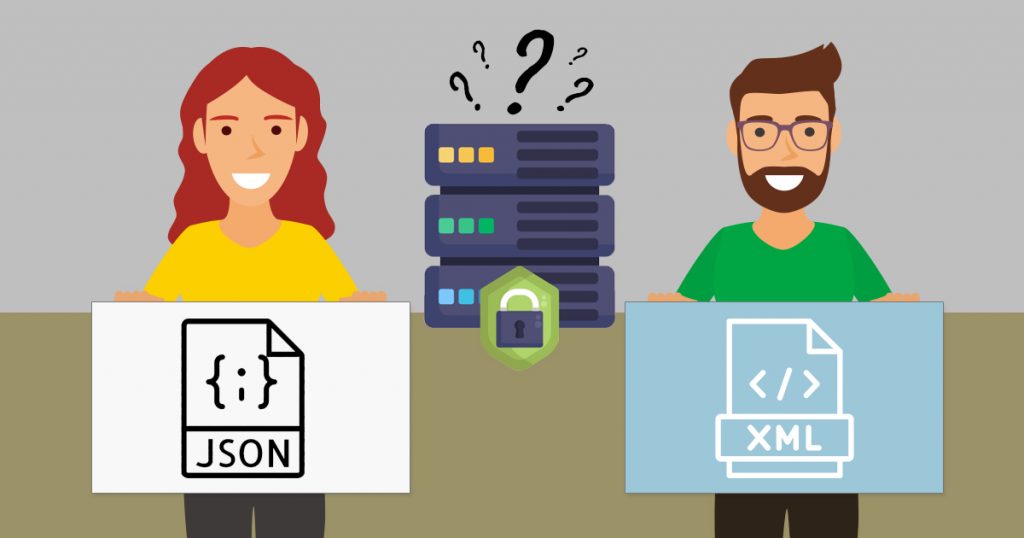Data storage and transfer play a critical role in modern software development. Whether you are working on a small web app or a complex enterprise system, the format you choose for storing and exchanging data can impact speed, scalability, and compatibility. Two formats dominate this space: JSON and XML. Many developers frequently debate between JSON and XML, each with strong supporters and valid use cases. Understanding the differences will help you pick the right one for your project.
Understanding the Basics
What is XML?
XML, or eXtensible Markup Language, was introduced in 1998 as a flexible way to store and share structured data. It organizes information in a tree-like structure using tags, attributes, and nested elements. Tags define elements, while attributes add details. XML can store complex data, and it supports schemas like DTD (Document Type Definition) and XSD (XML Schema Definition) to enforce strict validation rules. This makes it especially valuable in systems that require precise data structure definitions.
What is JSON?
JSON, or JavaScript Object Notation, appeared in 2001 as a lightweight data format. While inspired by JavaScript, it is language-independent and works across many programming languages. JSON uses two main data structures: objects made of key-value pairs, and arrays for ordered lists. These can be combined for complex data storage. Its concise syntax makes it easier for developers to read and write, especially when handling data in modern web and mobile applications.
What is the Difference Between JSON and XML?
The main difference lies in their structure and complexity. XML is more verbose, uses opening and closing tags, and supports metadata and namespaces. JSON is simpler, requires less space, and represents data using objects and arrays without extra markup. XML has built-in validation options, while JSON relies on external specifications like JSON Schema.
Why use XML over JSON
XML is often preferred in scenarios where data validation, metadata, and namespace support are essential. Large enterprise systems, government services, and financial platforms often rely on XML because it can describe complex relationships with precision. It also supports styling and transformation through XSL, making it versatile for multiple output formats like HTML or PDF.
Structure and Validation
DTD and XSD give XML the ability to strictly define allowed elements, attributes, and data types. For example, DTD might specify that a bookstore contains one or more book elements, while XSD can enforce data types like strings and numbers. This ensures consistency when exchanging data across different platforms.
Common Use Cases
XML is widely used in web services through SOAP, in content syndication formats like RSS and Atom, and in configuration files for tools like Hibernate or Spring. It also powers file formats like Office Open XML and SVG, and is used in business documentation standards like UBL.
Advantages of JSON over XML
JSON’s simplicity makes it faster to process and easier to read. Without closing tags, files are smaller, which can speed up data transfer. It supports native data types such as numbers, strings, booleans, arrays, and objects, making it a natural fit for APIs and web apps.
Structure and Ease of Use
JSON’s object and array system allows complex data structures without unnecessary markup. Developers can easily convert between JSON and JavaScript objects, which reduces processing time in browser-based applications.
Typical Applications
JSON dominates in RESTful APIs, data transfer between client and server, and configuration files like package.json in Node.js projects. It is also used in NoSQL databases like MongoDB and supported by relational databases like PostgreSQL and MySQL for storing and querying JSON data. Many data visualization libraries accept JSON as input for charts and dashboards.
Head-to-Head Comparison
Performance
In most cases, JSON is faster to parse because it is less verbose. XML parsing requires handling more markup and structure.
Readability
Developers usually find JSON easier to read and write due to its concise format. XML can be harder to scan without experience.
Complex Data Structures and Metadata
XML handles metadata, annotations, and namespaces within the document itself, while JSON would require separate structures. This makes XML better for cases where context and relationships between data elements are critical.
Making the Right Choice
Choosing between JSON and XML comes down to matching the format to the project’s needs. For lightweight, high-speed applications and APIs, JSON is often the better choice. For systems needing strict validation, complex hierarchical structures, or integration with legacy systems, XML might be a better fit.
Before deciding, check the API documentation of any external services you will use. Many APIs list the supported formats and how to request them. If the documentation is unclear, send a test request and check the Content-Type and Accept headers to see what formats are returned or supported. When in doubt, contact the service’s support team for confirmation.
A Practical Perspective on Choosing Between JSON and XML
Think of JSON and XML less as rivals and more as tools in the same kit. Each has strengths that can make or break a project depending on the situation. Instead of locking yourself into one, design your systems so switching or supporting both is possible. That way, you are prepared for future integrations, client requirements, or industry shifts you cannot predict today. In technology, adaptability is often the difference between software that lasts and software that becomes obsolete. Choosing formats with that mindset turns a technical decision into a long-term advantage.
